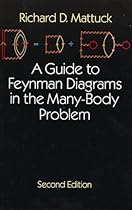Read A Guide to Feynman Diagrams in the Many-Body Problem: Second Edition (Dover Books on Physics) by Richard D. Mattuck, Physics Online
Read [Richard D. Mattuck, Physics Book] # A Guide to Feynman Diagrams in the Many-Body Problem: Second Edition (Dover Books on Physics) Online ^ PDF eBook or Kindle ePUB free. A Guide to Feynman Diagrams in the Many-Body Problem: Second Edition (Dover Books on Physics) Appendixes summarize the Dirac formalism and include a rigorous derivation of the rules for diagrams. Mattuck, formerly of the H. And, finally, it can be used as a supplementary reference in a many-body course.Chapters 1 through 6 provide an introduction to the major concepts of the field, among them Feynman diagrams, quasi-particles and vacuum amplitudes. It is intended primarily as a "self-study" book that introduces one aspect of many-body theory, i.e. "A great delight to read." — Ph

| Title | : | A Guide to Feynman Diagrams in the Many-Body Problem: Second Edition (Dover Books on Physics) |
| Author | : | |
| Rating | : | 4.77 (913 Votes) |
| Asin | : | 0486670473 |
| Format Type | : | paperback |
| Number of Pages | : | 464 Pages |
| Publish Date | : | 2017-07-28 |
| Language | : | English |
Appendixes summarize the Dirac formalism and include a rigorous derivation of the rules for diagrams. Mattuck, formerly of the H. And, finally, it can be used as a supplementary reference in a many-body course.Chapters 1 through 6 provide an introduction to the major concepts of the field, among them Feynman diagrams, quasi-particles and vacuum amplitudes. It is intended primarily as a "self-study" book that introduces one aspect of many-body theory, i.e. "A great delight to read." — Physics TodayAmong the most fertile areas of modern physics, many-body theory has produced a wealth of fundamental results in all areas of the discipline. Chapters 7 through 16 give basic coverage to topics ranging from Dyson's equation and the ladder approximation to Fermi systems at finite temperature and superconductivity. Orsted Institute and the University of Copenhagen, added to many chapters a new section showing in mathematical detail how typical many-body calculations with Feynman diagrams are carried out. Unfortunately the subject is notoriously difficult and, until the publication of this book, most treatments of the topic were inaccessible to the average experimenter or non-specialist theoretician.The present work, by contrast, is well within the grasp of the nonexpert. The book also lends itself to use as a reference in courses on solid state and nuclear physics which make some use of the
Appendixes summarize the Dirac formalism and include a rigorous derivation of the rules for diagrams. Unfortunately the subject is notoriously difficult and, until the publication of this book, most treatments of the topic were inaccessible to the average experimenter or non-specialist theoretician.The present work, by contrast, is well within the grasp of the nonexpert. It is intended primarily as a "self-study" book that introduces one aspect of many-body theory, i.e. In addition, new exercises were included, some of which gave the reader the opportunity to carry out simpler many-body calculations himself. A new chapter on the quantum field theory of phase transitions rounds out this unusually clear, helpful, and informative guide to the physics of the many-body problem.Unabridged Dover (1992) republication of the second edition published by McGraw-Hill International Book Company.. Chapters 7 through 16 give basic coverage to topics ranging from Dyson's equation
What can I add? I can hardly add anything to the praise given to this book by other reviewers. Though one should, undoubtedly, get acquainted with more serious books on the subject, I have to confess that I am still unaware of the book that presents the material together with the terms used in the scientific papers.For example, I greatly admire the book by Abrikosov's et al. (AGD), and I completely agree that after reading it (and Keldysh paper) one is completely prepared to using Green's functions in serious research. But the terms like "rainbow", "bubble", "particle-particle" and "particle-hole" pro. "A very strong and fun introduction to many-body theory" according to Brendan M.. A very strong and fun introduction to many-body theoryever! Right up there with my notes from Sydney Coleman's notes on QFT!!. Who says QFT is not fun to teach? This book is a counterexample to the idea that one cannot write a book on quantum field theory and keep a sense of humour. Quantum field theory of course is notoriously difficult, both in terms of its conceptual foundations and in calculating meaningful answers from its formalism. Perturbation theory has been the most succesful of the methods of calculation in quantum field theory, and the visualization of the terms of the perturbation series is greatly assisted by the use of Feynman diagrams. The author has done a great job in the elucidation of these diagrams, and readers will not on
Download A Guide to Feynman Diagrams in the Many-Body Problem: Second Edition (Dover Books on Physics)
Download as PDF : Click Here
Download as DOC : Click Here
Download as RTF : Click Here
